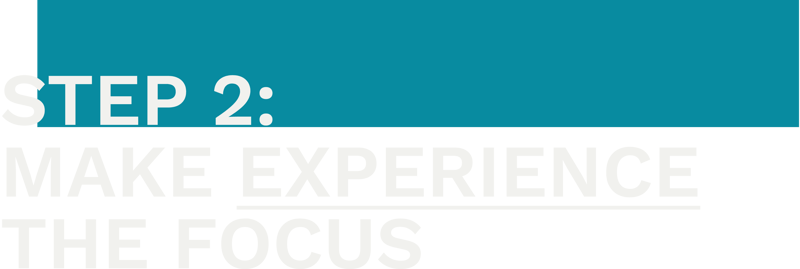
You’ve heard the buzz. Maybe you’ve rolled your eyes. We get it. If you’re in marketing, you’ve seen your share of shiny new acronyms, each promising to revolutionize everything (and half of them don’t even make it past the hype phase).
And yeah, we know ABX (Account-Based Experience) can sound like just another one of those outlandish ideas. (Side note: If anyone’s guilty of championing the occasional “out-there” concept, it’s us.)
Here’s the thing: ABX isn’t a total reinvention of the wheel—it’s a smarter, more focused way to use what you already know. It’s the kind of thing that can feel exciting in theory but overwhelming in practice—hard to track, tough to define, and easy to overcomplicate. So we’re breaking it down.
Not all accounts are created equal. Treating them the same wastes time, money, and resources.
The first step in ABX is recognizing where your prospects are in their journey—and tailoring your approach accordingly.
Move beyond firmographics (like title, company size, location) to focus on factors that make communication and engagement meaningful, such as where they fall on a knowledge and engagement scale.
Here’s how we do it.

ABX isn’t just about who you target—it’s about how you engage. The right accounts won’t respond to generic campaigns or one-size-fits-all messaging anymore. What makes ABX different is its focus on delivering personalized, thoughtful experiences that actually resonate. And when you align your outreach with where prospects are in their journey, every interaction feels intentional and impactful.
But it’s not just about touchpoints; it’s about defining moments—those pivotal interactions that reveal your brand's essential nature and stick with prospects long after the email is read or the call ends. They shape perceptions in ways no generic drip campaign ever could.
The best part? It’s fun. And not only is it more effective, but it also feels more human—on both sides. When your marketing creates genuine, memorable connections, prospects notice. That’s what makes you stand out—not just in the moment, but long after the first touch.
Draw these accounts in with creative, memorable first touches. Go big on first impressions—use creative, non-salesy tactics that grab attention and make them curious about your value.
They may not be ready to buy, but they know your name. They see your value, and you’ve piqued their interest.
Think about it like this—
.png?width=700&height=295&name=CONFERENCE%20(1).png)
These companies receive personalized, helpful interactions that deepen trust, they see you as more than a vendor.
A transactional approach here risks losing them to competitors who are building trust and connection. Become their go-to source for insights and collaboration.
Here’s our best tip for engaging with these accounts—
.png?width=700&height=403&name=ALL%20ABOUT%20YOU%20(2).png)
Now’s the time to make it easy (and exciting) for them to choose you.
A lack of alignment, unclear ROI, or overly aggressive tactics can derail the deal. Focused, thoughtful engagement can tilt the scales in your favor
Consider this the next time you’re at this stage—
.png?width=700&height=325&name=IN%20THEIR%20SHOES%20(2).png)

Goodbye performance marketing dashboards. Hello, account-based metrics.
Traditional metrics like MQLs and SQLs just don’t cut it anymore. They don’t tell you if your audience gives a shit about your product or plans to buy.
Instead, shift your focus to metrics that prioritize connection and engagement with your target accounts.
.png?width=600&height=557&name=MEASURE%20DIFFERENTLY%20(1).png)

If you take nothing else away from this, know that these three steps mean nothing without time—the time that needs to be given for ABX to work. What’s the opposite of a hard and heavy out-of-the-gate sales pitch? It’s a strategy that leads a horse to water and waits for it to drink.
.png?width=700&height=132&name=CLOCK%20(1).png)
And to wrap this up nicely, know that none of these ABX tips work if they aren't applied to a model that pulls your marketing function outside the traditional connect to convert mindset. That doesn't work anymore. Instead, remember CECE — Connect, Engage, Convert, Expand.
Why? Because ABX isn’t just about nailing a killer email sequence or crafting the perfect ad. It’s about creating a continuous, holistic experience that doesn’t stop at the first click or even the first deal. If you’re not connecting meaningfully, engaging authentically, converting thoughtfully, and expanding consistently, your ABX strategy is just another campaign lost in the noise.
We are TSC—and we're redefining marketing for tech companies. We’ve helped tech companies of all sizes shift from stale ABM playbooks to creative, experience-first ABX strategies. Whether it’s building community, aligning teams, or designing unforgettable campaigns, ABX is shaping every strategy we create.
Wanna chat strategy? See if we’re a good fit? Head on over to tsc.chat and fill out our contact sheet. We’ll be in touch.









.png?width=735&height=100&name=DEEPEN%20CONNECTIONS%20(1).png)

